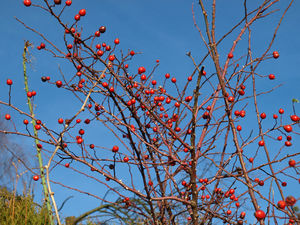Crataegus oxyacantha
| See Also | Botanical Monographs |
|---|
Hawthorn (Crataegus oxyacanta) is considered one of the most important cardiac tonics. To explore the characteristics, medicinal uses and prescribing considerations of this herb in more detail, check out the references indicated.[1], [2]
Contents
Characteristics
AKA C. oxyacantha, C. laevigata
- Common Names: Hawthorn
- Family: Rosaceae
- Habitat: Crataegus can be found in the U.K. and Europe where it is used to fence cattle.
- Parts Used: Berries, root, flower bud before it opens
- Constituents: triterpene glycosides, oligomeric procyanidins
- Medicinal Actions: cardiac tonic, antioxidant, nutritive (to the heart), collagen stabilizing
Uses
Historical Uses:
| Article | Beyond Hawthorn, NDNR; 2012 October |
|---|
| Article | Hibiscus, Hawthorn, and the Heart , Natural Medicine, ; 2011 July[1] |
|---|
Crataegus has been traditionally used to treat conditions of the heart and circulatory system as well as asthma, diabetes, nervous tension, anxiety and kidney stones. It is considered one of the most important cardiac tonics.
Medicinal Uses:
- cardiac weakness with valvular murmurs, sighing respiration, dyspnea with cardiac pain, especially with depression.
- mitral regurgitation.
- rapid, feeble heart, deterioration or degeneration of the heart from age.
- anemia with heart irregularity.
- cardiac hypertrophy.
- heart strain from overexertion, poor coronary artery circulation.
- arrhythmia, especially extrasystole, paroxysmal tachycardia, influenza, diphtheria, scarlet fever.
- myocardium insufficiency requiring Digitalis spp. or Strophanthus kombe
- bradycardia of the elderly (preventive treatment for hypertension).
- mild congestive heart failure.
- mild hypertension.
Prescribing Considerations
The information provided is intended to augment the treatment from a naturopathic doctor or other trained medical professional. Although most herbs are generally safe, it is recommended that you avoid self-prescribing especially when there is an underlying ongoing medical condition, if you are on any prescription medications or if you are pregnant or breastfeeding.
Formulations and Preparation
- Tincture - 5-120 drops (4-6mL) three times daily
- Fluid extract - 10-60 drops three times daily
- Infusion - 3-5g (flowers and berries)
- Freeze dried - 1-1.5g daily
- Standardized extract - (1.8% vitexin-4'-rhamnoside or 10% procyanadin) 100-250mg three times daily
- Solid extract - 1/4 tsp three to four times daily
Can be used long term
Safety
The safety and prescribing considerations for this herb include:[3] [4]
- Generally regarded as safe.
- Side-effects are rare but may include nausea, dizziness, and headaches.
- Drug-Herb Interactions.[3]
- Digoxin, Digitoxin, and Related Cardiac Glycosides - Potential or theoretical beneficial or supportive interaction with professional management, prevention or reduction of drug adverse effect; Plausible additive inotropic and antiarrhythmic effects (interaction not established, possibly overstated). Crataegus may enable lower drug levels, reducing digoxin toxicity.
- Doxorubicin and Related Anthracycline Chemotherapy - Potential or theoretical beneficial or supportive interaction with professional management, prevention or reduction of drug adverse effect; Theoretical reduction of drug-induced cardiotoxicty. Adopt and continute Cratague long-term post-chemotherapy.
- Hydrochlorothiazide and Related Thiazide Diuretics, Combined and Triamterene - Beneficial supportive interaction with professional management, prevention or reduction of drug adverse effect; Additive beneficial effects on heart failure parameters
References
- ↑ Boon Heather, Smith Michael (2009) 55 Most Common Medicinal Herbs: The Complete Natural Medicine Guide Second Edition Institute of Naturopathic Education and Research, CCNM Toronto.
- ↑ Godfrey Anthony, Saunders Paul, Barlow Kerry, Gowan Matt (2011) Principles and Practices of Naturopathic Botanical Medicine, Advanced Botanical Medicine. V3 CCNM Press, Toronto.
- ↑ 3.0 3.1 Stargrove Mitchell Bebell, Treasure Jonathan, McKee Dwight L (2008) Herb, Nutrient and Drug Interactions: Clinical Implications and Therapeutic Strategies.
- ↑ Brinker Francis (1997) Herbal Contraindications and Drug Interactions: Plus Herbal Adjuncts With Medicines, 4th Edition Eclectic Medical Publications.
